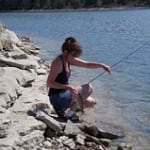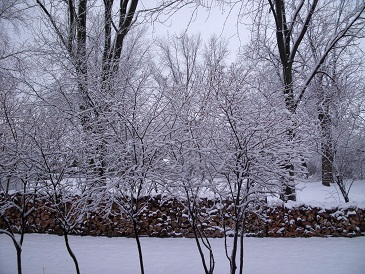DAWN OF A NEW SEASON. POND MANAGEMENT IS ABOUT TIMING – BY BOB LUSK
Thursday, January 27, 2011 at 5:27pm
Water temps, not dates, the real key
Remember Forrest Gump? He was running along a lonely stretch of highway, minding his own business, when he steps in a pile of nature’s fertilizer. Forrest looks down, then back at the front guy in the crowd behind him, and says, “It happens.”
In the world of pond management, “it” sure does. Let’s examine “it.”
Beginning late each winter, extending into spring, then deep into summer, I get the same questions, from different people, sometimes in different states, but roughly the same questions about their fishing ponds.
Example: “I fertilized my lake, and nothing happened. The water is just as clear as ever.”
Or, maybe this one: “I followed label directions, fertilized the right amount for my pond, and bottom weeds have taken over.”
No pretty green water, no plankton bloom in their fishing ponds.
What happened? “It” didn’t work.
What gives? Is “it” the fertilizer? Or, maybe the water? Was “it” applied correctly? Was the compound properly distributed throughout the pond, then allowed to fully dissolve into the water column, the way Pond Boss says to do “it”?
There’s an old adage for real estate people that relates to the three basic principles of the property — location, location, location. In pond management, “it” is “timing, timing, timing.”
You can add fertilizer to your water, applying at the proper rates, the proper N-P-K (nitrogen-phosphorus-potassium) mix, until you are blue in the face, and never get a bloom. This is especially 1 if you were to fertilize during the coldest spell of the winter. Timing. The right pond management technique, perhaps, but it was used at the wrong moment.
As you plan for the New Year for your favorite fishing pond, the new growing season, start putting together your basic pond management strategy for the next 12 months. In Texas, the Agriculture Extension Service provides excellent information in the form of a calendar. Trouble is, on any given spring day, the temperature at the southern tip of the Lone Star state may hit 85 degrees, while the folks in Amarillo, located in the middle of the Texas Panhandle, may be shoveling snow off the sidewalk. So much for a pond management schedule dictated by pages on a calendar.
Instead, let water temperature be your guide. Check the Pond Boss display ads for catalog distributors and buy a good thermometer. Then use it to check water temperatures on a regular basis.
Don’t get too concerned about the mechanics of this, whether you take the temperature six inches below the surface or 3 feet deep, just make sure to place the thermometer in approximately the same place each time in your fishing pond.
If you can’t be at your pond all the time, check temps as often as possible. Write your findings in a notebook. Watch your pond temperature patterns, and keep notes. Two or three years of sound temperature record keeping will put you in the pond management driver’s seat.
Here’s how: Let’s say, for instance, that at 45 degrees, you start noticing the onset of filamentous algae growth in your fishing pond. Write that in your notebook. At 55-60, fish began coming to your feeder. Make a note. At 62-68, bass went on their spawning nests. Two weeks later, baby bass are seen in schools, around the edge of your fishing pond. Write it down. All of it.
Those little facts will help you achieve pond management goals next year, and the year after, beginning with the first hint of filamentous algae, which tends to get worse as water temperatures rise. With all biological activity that occurs in your fishing pond, there is a direct relation to water temperature.
Take plankton for an example. Desirable plankton blooms, adequately fed, will not thrive until water temps in your fishing pond are consistently above 60 degrees. That’s not to say you can’t find plankton in winter. You can.
But, to properly feed baby fish in your pond, 60 degrees is “it.” Sixty is the trigger point.
What about feeding pelleted fish food like Purina Aqua Max, you might ask? Different fish respond to different temperatures. When your temps hit 50-55 last Fall, channel cat eased away from the fish feeder, into the murky depths of your fishing pond to hunker down in a big school. But, your feisty bluegill probably came to the fish feeder even as temps dropped into the lower 40’s.
I often get asked about stocking fingerlings in a new fishing pond. When should you introduce fingerlings to a new environment?
With our pond management clients, we urge fishing pond owners to avoid extremes. Both hot and cold can be stressful for handling fish. Oh yes, fish can certainly survive their extremes, once they arrive in the fishing pond. But getting them from the hatchery to your pond can be tricky during really hot or really cold. Transport fish during warm or cool times.
Here’s a simple temperature “calendar” to bring pond management techniques to a sharper focus:
Temps below 32 degrees
Ice. Aerate northern ponds, if possible, and keep snow cover off clear ice. This is a great opportunity to prepare brush piles, rocks, pipe, or other materials on top of ice, where they can sink, after thaw, for your fish cover.
32-42 degrees
Do not expect fish to feed. Warmwater fish are too sluggish, trout feeding is minimal.
42-48 degrees
Macrophytic aquatic plants are dead. Good time to install cover into barren areas. Be sure to put cover in mid-depth areas of your fishing pond, relatively near shore.
48-55 degrees
Bluegill will feed, especially if conditioned to fish food pellets. Filamentous algae begins to grow around fishing pond edges, especially during warm afternoons. Peak trout feeding temperatures.
55-58 degrees
Channel catfish come to life, and begin searching for food. Bluegill activity escalates, Bass begin moving from structure. Filamentous algae thickening. Trout active.
58-62 degrees
Fertilize fishing ponds with clear water! Do not dally. Bass begin showing signs of nesting, preparing crater-shaped spots, 4-6 feet deep, 18 inches in diameter, for spawning. Filamentous algae in full growth stage. Begin checking for plankton bloom 5 or 6 days after fertilizing, as temps continue their Spring rise. Time to begin stocking fingerling fish into new ponds, or adult fish for corrective stocking situations. Trout still active and growing. Crappie on nests.
62-68 degrees
Worldwide, this is prime spawning temperature range for largemouth bass in your fishing pond. Plankton blooms beginning to color the pond water. Measure pond water visibility, shooting for 18-24″. This is still a good time to fertilize your pond. Redear sunfish and bluegill begin preparing and sitting on nests. Trout active and growing. Cattails begin to grow, along with peripheral reeds. Watch for beginnings of rooted aquatic plants underwater in your pond.
68-72 degrees
The bass spawn wanes, with schools of baby bass beginning to appear. Bluegill are on nests. Plankton reach optimum growth. Measure visibility in the fishing pond. Rooted plants growing, cattails and reeds tall. All fish feeding well.
72-76 degrees
Keep measuring pond water visibility; maintain plankton blooms. Watch for plankton bloom beginning to darken from bright green to an olive green. Cattails and reeds reaching maturity. American lotus and select lily pads begin to show themselves. Peak operating temperatures for all warm water fish. Heavy feeding, both natural food and from your feeders. Young of the year bass, bluegill and redear can be observed. Channel catfish beginning their spawning rituals. Monitor plankton bloom, keep goals in sight. Trout tend to become sluggish.
76-80. degrees
Trout are dead. Warmwater fish on full feeding throttles, fish growth rates max. Rooted aquatic plants maturing, still rapidly growing. Filamentous algae beginning to disappear. Plankton, when fed properly, is thriving. Watch for plankton bloom color to shift from olive green to a greenish brown. Be careful when boosting your pond algae bloom with fertilizer. Use maintenance doses, only. Keep checking visibility; use maintenance doses of fertilizer as pond water visibility increases beyond 24-30 inches. Floating plants such as duckweed, azolla, become noticeable. Good time to begin treating unwanted vegetation. Be sure to have stocked fingerlings by now.
80-84 degrees
Warm water fish are active, and plankton tends to grow quite rapidly. Do not over-fertilize an overactive plankton bloom in your pond. Measure pond water visibility, watch as plankton bloom color changes. When plankton shifts to a brownish/ green color, it has shifted from mostly phytoplankton (plant plankton) to zooplankton (animal plankton). Zooplankton blooms rapidly deplete their food source, phytoplankton, and then the bloom will “crash”. Zooplankton run out of food, zooplankton die, and sink in your fishing pond. Pond water rapidly clears. Either feed the algae bloom, or let it crash, you choose, based on your pond management goals. By now, baby fish hatched in your fishing pond are reaching fingerling sizes, and clear pond water makes forage fish available to bigger predator fish. But, remember, clear water lets sun penetrate deeper in the pond water column, expanding rooted plant territory.
84-88 degrees
Be wary of fertilizing your fishing pond. Better to under-fertilize a lot than over-fertilize a little. Biological activity, especially microbes, in water, reaches most rapid life cycle movement in warmer water. Fish metabolism beginning to slow, growth rates reaching summer doldrums. Vegetation reaching maximum growth rates and penetration in your pond.
88-92 degrees
Even warmwater species begin to hunker down in their “survival” mode. Limited feeding times, fish get sluggish. Vegetation at maximum coverage. Watch pond water chemistry, especially plankton blooms more dense than 18 inches visibility.
Above 92 degrees
Check your pond’s plankton. Drink lots of fluids. Be wary of chemically treating excessive aquatic plants. Killing too much vegetation, too fast, can devastate your fishery. Oxygen depletions are most common.
Our friend Forrest would say, “Timing is as timing does.”
Humans seem to rely on a calendar, but nature doesn’t always oblige, and her “work schedule” varies greatly from region to region. Observe pond activity, and train yourself to rely on the thermometer.
Rethink your annual pond management schedule to coincide, not with readings on a watch or even a calendar, but with temperature levels. It’s nature’s way, and it should be yours.
POND BOSS Magazine is the world’s leading resource for fish, pond and fisheries management information including discussions on muddy water, raising trophy fish, fish feeding, building a pond, algae control and more. Check us out at www.pondboss.com or contact Bob Lusk, the Pond Boss himself, at 903-564-5372. His books, Basic Pond Management, Raising Trophy Bass and Perfect Pond, Want One, may be purchased by calling 800-687-6075 or ordering online at www.pondboss.com



